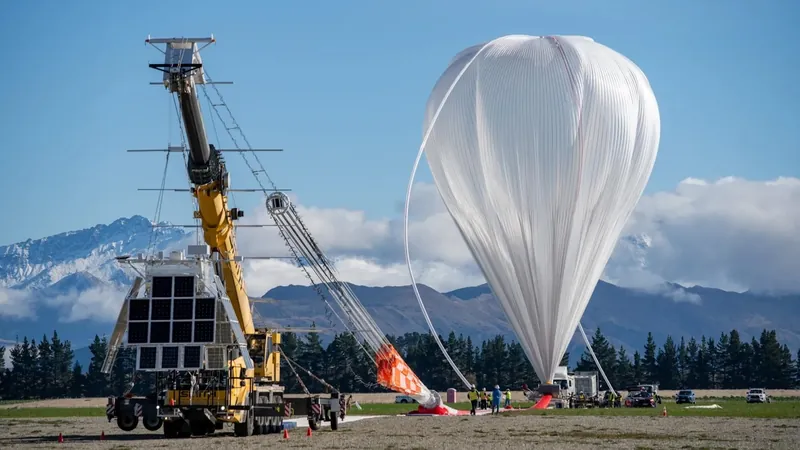
NASA’s Balloon Breaks Records: A Sky-High Adventure in Just 16 Days!
2025-05-07
Author: Wei Ling
An Unprecedented Journey Across the Southern Hemisphere
In an astonishing feat of engineering, NASA has successfully flown one of its colossal super-pressure balloons around the Southern Hemisphere in a mere 16 days. This incredible journey, which wrapped up on May 4 after a milestone crossing at 169.24 degrees east longitude, underscores the balloon's ability to maintain altitude both day and night—making it an ideal platform for extensive scientific research.
Why Balloons? Cost-Effective Science at New Heights
Launched from Wānaka, New Zealand, the massive balloon—a behemoth roughly the size of a football stadium—ascended to an impressive altitude of 21 miles (33 km) just two hours post-launch. While it predominantly floated over the vast ocean, lucky observers near the launch site managed to spot this drifting giant shortly after it took to the skies. Unlike traditional rocket missions, this balloon presents a budget-friendly way to gather significant data over extended periods, eliminating the need for complex launching technology.
Mission Challenges: Navigating Nature's Struggles
Despite its pioneering accomplishments, the mission faced an early conclusion due to a minor leak that affected altitude stability. While the balloon thrived in daylight, it succumbed to colder nighttime temperatures, dipping to as low as 11 miles (18 km) during its transit over chillier areas and stormy weather. Ensuring safety, mission control guided the balloon to a designated drop zone in the Pacific Ocean, where it made a gentle descent, minimizing environmental impact.
Valuable Data Amidst the Waves
Gabriel Garde, chief of NASA's Balloon Program Office, highlighted the silver lining to the mission's premature end, stating, "While recovering the hardware would have been ideal, we successfully transmitted all vital scientific data back to Earth." The balloon was equipped with a state-of-the-art instrument—the High-altitude Interferometer WIND experiment (HIWIND)—which collected key atmospheric data. This research helps scientists better predict changes in the ionosphere, a crucial area that influences GPS and radio communications.
Paving the Way for Future Exploration
Even with the mission concluding ahead of its anticipated 100-day timeline, NASA officials celebrated its accomplishments. The primary goal—to test and validate the super-pressure balloon technology for future scientific endeavors—was achieved, paving the way for more groundbreaking research and exploration in the skies above.


 Brasil (PT)
Brasil (PT)
 Canada (EN)
Canada (EN)
 Chile (ES)
Chile (ES)
 Česko (CS)
Česko (CS)
 대한민국 (KO)
대한민국 (KO)
 España (ES)
España (ES)
 France (FR)
France (FR)
 Hong Kong (EN)
Hong Kong (EN)
 Italia (IT)
Italia (IT)
 日本 (JA)
日本 (JA)
 Magyarország (HU)
Magyarország (HU)
 Norge (NO)
Norge (NO)
 Polska (PL)
Polska (PL)
 Schweiz (DE)
Schweiz (DE)
 Singapore (EN)
Singapore (EN)
 Sverige (SV)
Sverige (SV)
 Suomi (FI)
Suomi (FI)
 Türkiye (TR)
Türkiye (TR)
 الإمارات العربية المتحدة (AR)
الإمارات العربية المتحدة (AR)